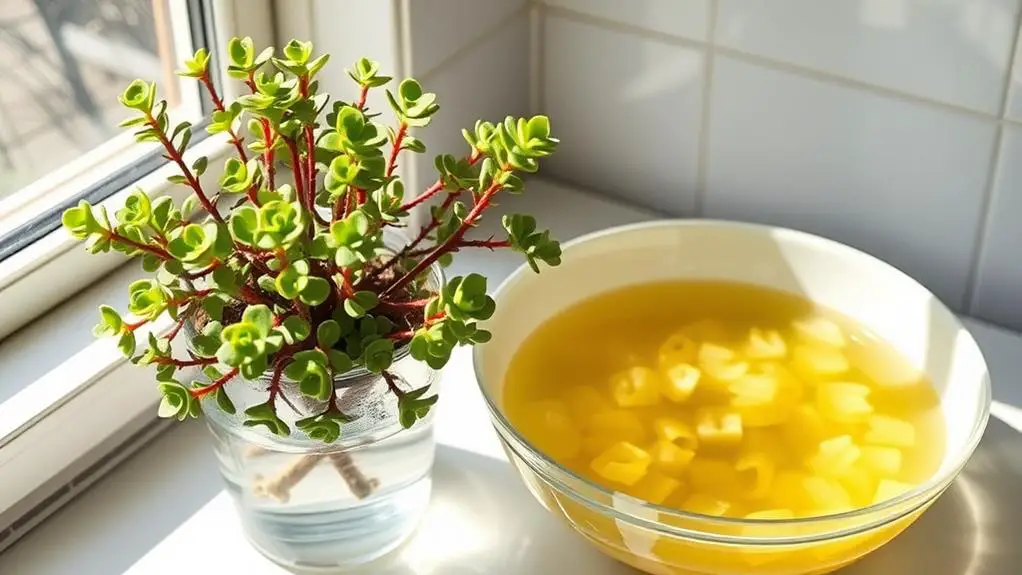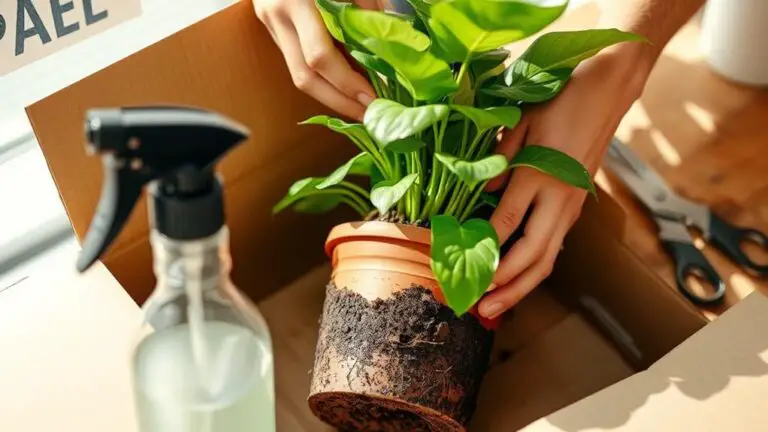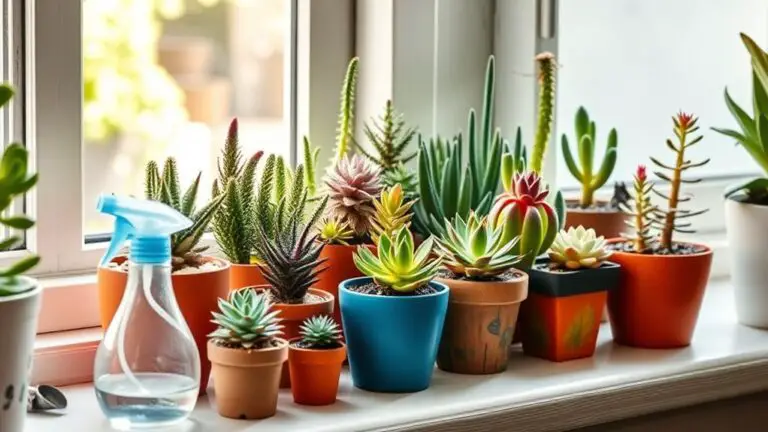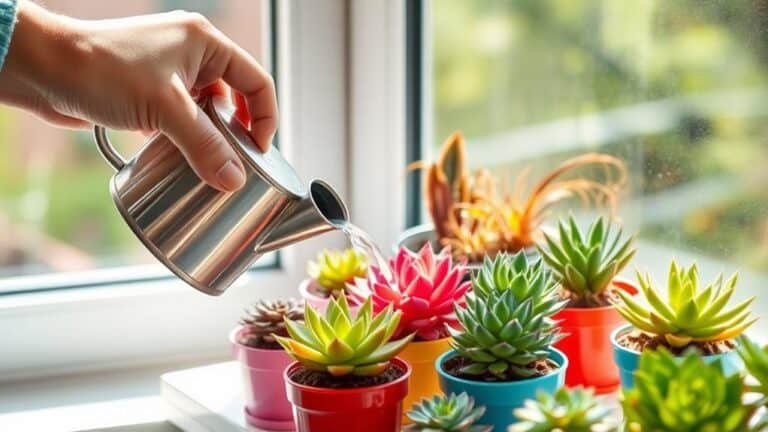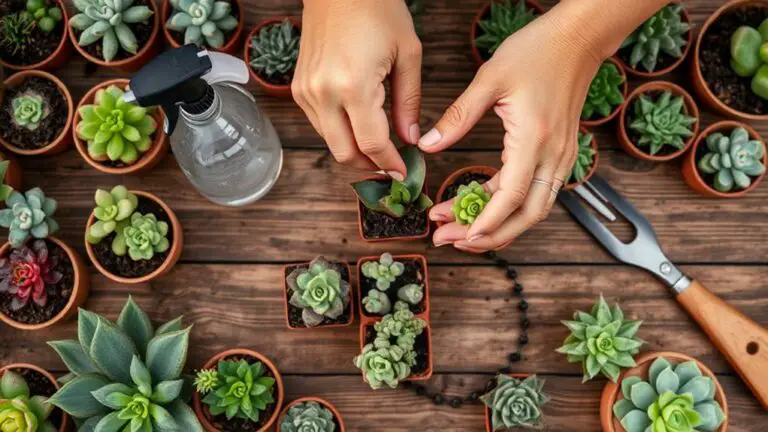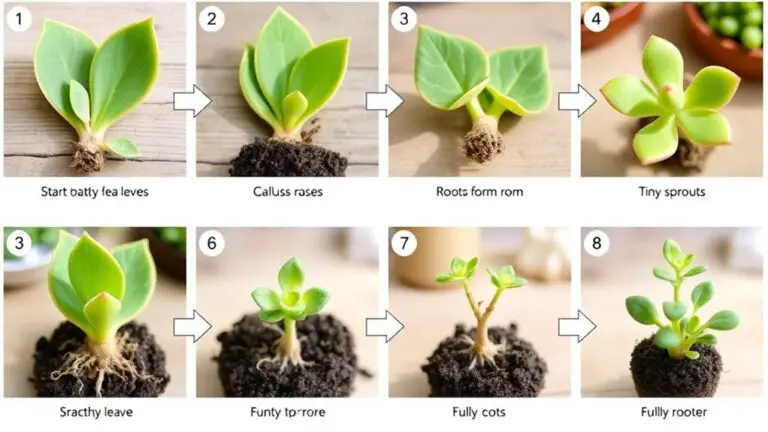How to Use Leftover Pasta Water to Nourish Succulents
You might be surprised to learn that leftover pasta water can be a valuable resource for your succulents, offering a boost of essential nutrients. To make the most of this unexpected fertilizer, guarantee the water is unsalted and free of oils before cooling it to room temperature. Wondering how to prepare it properly and how often to apply it to your plants? There are specific steps you need to follow to avoid common pitfalls and guarantee your succulents thrive. Let's explore the benefits and techniques to master this sustainable watering method.
Benefits of Pasta Water
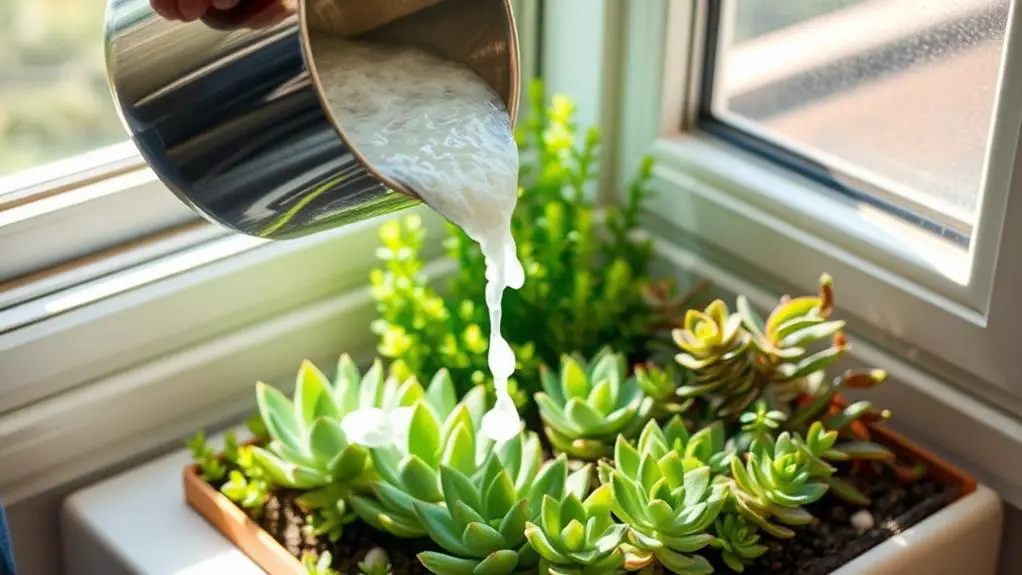
When you use leftover pasta water for your succulents, you're tapping into a rich source of water-soluble nutrients that can greatly benefit your plants. This simple practice can make a big difference in your succulent care routine. The cooled pasta water contains vitamins like B and C, which are crucial for promoting healthy growth.
One of the most advantageous aspects of using pasta water is the starches it contains. These starches nourish beneficial soil bacteria, enhancing microbial activity. This microbial boost helps your succulents grow stronger and healthier.
The water also has trace minerals like calcium, zinc, iron, phosphorus, and potassium. These minerals contribute to the overall nutrient supply, supporting your succulents' needs without overwhelming them.
Using pasta water as a fertilizer is also an environmentally friendly choice. It reduces food waste and provides organic nourishment to your plants. Unlike traditional fertilizers, pasta water has a gentle nutrient profile. It doesn't have high nitrogen concentrations, which can sometimes harm succulents. Instead, it offers a balanced mix of nutrients that's ideal for these plants.
Incorporating leftover pasta water into your gardening routine is a simple and beneficial way to support your succulents' health and vigor.
Key Nutrients for Succulents
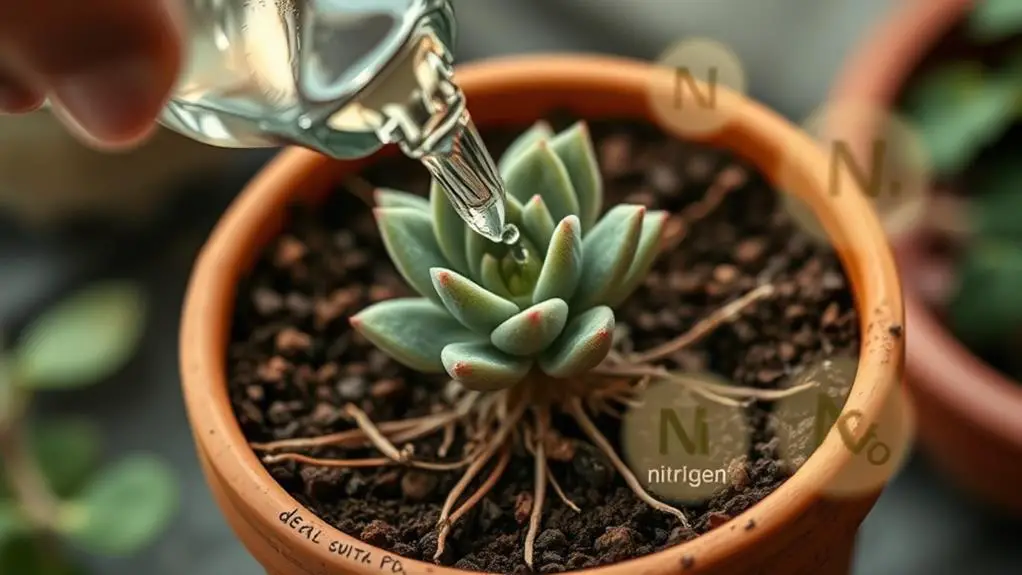
Using leftover pasta water for your succulents can be a game changer thanks to its essential nutrients like calcium, zinc, and potassium.
Not only do these nutrients promote healthy growth, but the starch content also boosts soil health by supporting beneficial microbes.
To get the most out of pasta water, use it regularly and watch your succulents thrive without needing chemical fertilizers.
Essential Nutrient Content
Although often discarded, leftover pasta water is a hidden gem for succulent enthusiasts. This simple byproduct is packed with essential nutrients that your succulents need for thriving growth. By using pasta water, you're giving your plants a natural boost of vitamins and minerals without relying on chemical fertilizers.
Here's what pasta water offers:
- Calcium, Zinc, Iron, Phosphorus, and Potassium: These minerals are essential for the overall health and development of succulents. They help plants by improving root strength and promoting vibrant leaves.
- B Vitamins: The water is rich in B vitamins like niacin, thiamine, and riboflavin, which support plant vitality and resilience.
- Starches: These promote beneficial soil bacteria, enhancing the absorption of nutrients by the roots.
- Minerals: The mineral content helps improve soil structure and aeration, leading to healthier roots.
Using pasta water as an organic fertilizer reduces the need for chemical alternatives, making it a more sustainable choice for your garden.
With these nutrient-packed benefits, you can help your succulents grow stronger and more beautiful. So next time you cook pasta, save that water and watch your plants thrive!
Soil Health Benefits
The benefits of leftover pasta water extend beyond just delivering nutrients directly to your succulents; it also greatly enhances soil health. By using pasta water, you're giving your soil a boost of essential nutrients like calcium, iron, potassium, and phosphorus. These nutrients help your succulents grow strong and healthy.
The natural starches in pasta water promote microbial activity in the soil. This means beneficial bacteria thrive, helping your succulents absorb nutrients more efficiently. These microbes also improve soil structure and aeration, which is vital for the health of succulent roots. Better soil structure means your succulents' roots can access water and nutrients more easily.
Pasta water also contains vitamins B and C. These vitamins support the resilience of your succulents, helping them thrive in various conditions. This makes your plants stronger and more adaptable to changes in their environment.
Using pasta water is an eco-friendly way to recycle kitchen waste while enriching your soil. It's a simple, natural alternative to commercial fertilizers. By incorporating pasta water into your gardening routine, you're not only caring for your succulents but also taking a step towards sustainable living.
Regular Application Tips
To keep your succulents thriving, consider incorporating pasta water into your regular care routine. Regular application of pasta water every 2-4 weeks can deliver essential nutrients like calcium, iron, and potassium, promoting healthy growth.
The starches in pasta water also enhance microbial activity in the soil, improving soil structure and aeration, which are vital for succulent root health.
Here's how to get good results:
- Mix one cup of unsalted pasta water with one cup of distilled water to create a diluted solution that prevents over-fertilization.
- Check soil moisture levels after watering plants with pasta water to avoid root rot. Succulents need well-draining soil.
- Monitor your plant's response to guarantee balanced nutrient supply and adjust the frequency based on growth patterns and soil health.
- Use this method during the growing season for the best results, as this is when succulents are actively taking up nutrients.
Proper Pasta Water Preparation
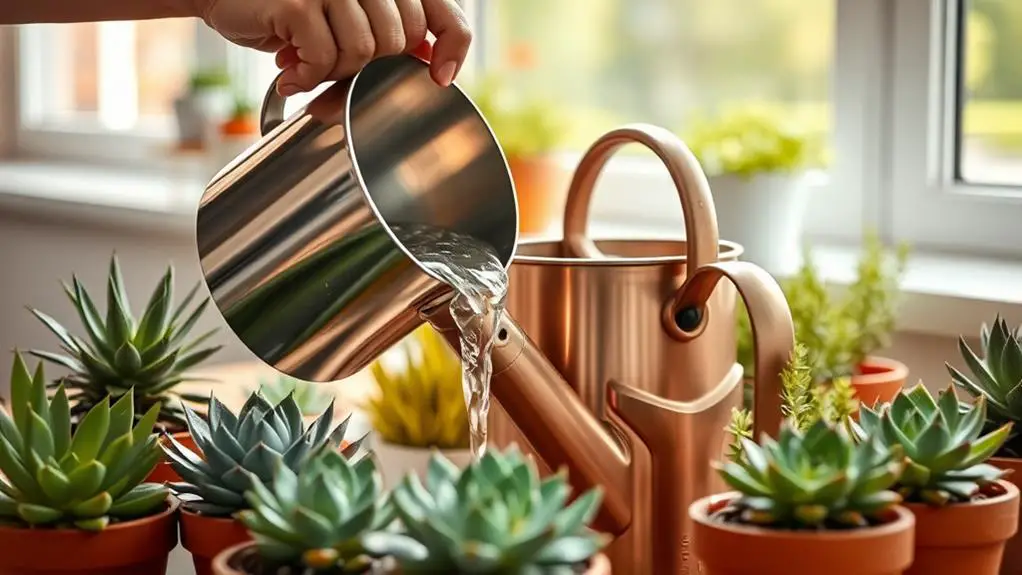
To prepare your pasta water for succulents, start by rinsing the pasta before cooking to remove any dust, which helps create cleaner water.
After boiling, make sure to strain out any solid pieces and let the water cool to room temperature to avoid harming the plant roots.
Rinsing and Straining Water
When preparing pasta water for your succulents, it's important to start by rinsing the pasta before cooking to remove any dust and impurities. This guarantees that the pasta water you use is clean and beneficial for your plants.
After cooking your pasta, make certain to strain the water to eliminate any solid pasta remnants. This step is significant because leftover bits can cause mold and make the water less effective for your succulents.
Once you've strained the water, let it cool down to room temperature. Hot water can harm plant roots and foliage, so cooling is crucial.
It's important to avoid using pasta water that contains added salt or oil. These ingredients can be detrimental to your succulents, so always use plain pasta water.
Here are the steps to prepare your pasta water properly:
- Rinse the pasta before cooking to remove dust and impurities.
- Strain the pasta water after cooking to eliminate solid remnants.
- Allow the water to cool to room temperature before use.
- Avoid using salted or oiled pasta water to prevent harm to your succulents.
Cooling Before Application
Cooling the pasta water before applying it to your succulents is an essential step in ensuring their health. Hot water can damage the delicate leaves and roots of your succulents, so always allow the leftover pasta water to cool to room temperature. This simple step can make a big difference in how well your plants absorb the nutrients.
After cooking your pasta, strain the water to remove any solid remnants. This helps prevent mold growth, which can harm your succulents.
It's important to remember that using unsalted pasta water is best, as salt can dehydrate your plants and negatively affect their health.
Once the pasta water has cooled, store it in a clean, sealed container in the refrigerator. You can keep it there for up to a week, ensuring it retains its nutrient quality.
When you're ready to use it, just take a little out and let it come to room temperature again before applying it to your plants.
Dilution for Safety**
In preparing pasta water for your succulents, always start by diluting it with equal parts distilled water. This step is essential for the dilution for safety, guaranteeing that using leftover pasta water doesn't harm your plants. Salty water can be detrimental, so balancing it with distilled water creates a gentler solution.
Let's go over some key steps to make your pasta water safe for succulents:
- Cool the water: Verify the pasta water is at room temperature before using it. Hot water can damage the roots of your succulents.
- Strain thoroughly: Remove any solid remnants to prevent mold growth in the soil.
- Avoid additives: Never use flavored or seasoned pasta water. These additives can harm your succulents.
- Monitor usage: Apply the diluted water every 2-4 weeks during the growing season and watch for signs of over-fertilization.
Watering Techniques
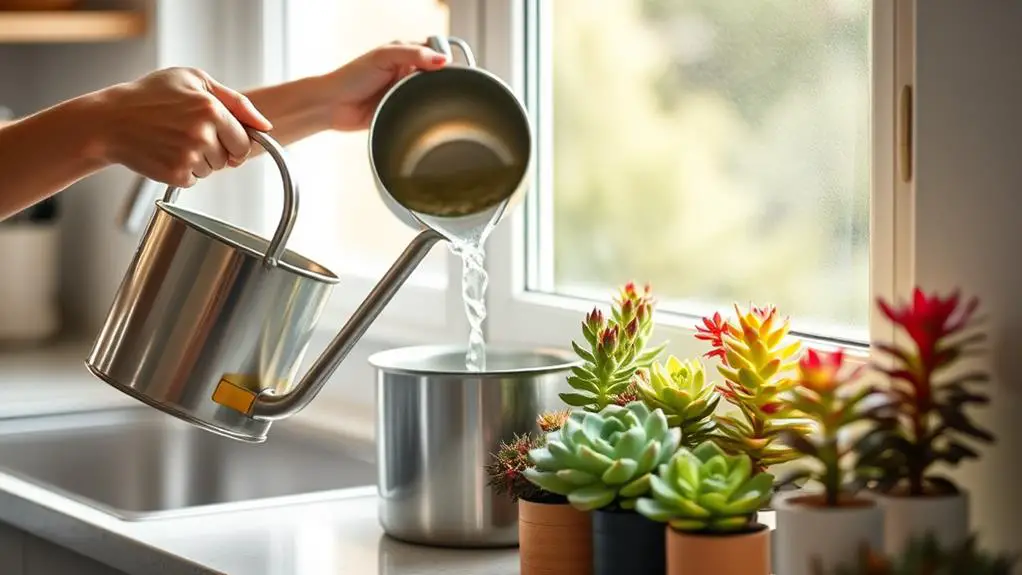
There are several effective techniques for watering succulents with leftover pasta water, each offering unique benefits for plant health. By using these watering techniques, you can help them grow healthier and stronger. One method is top watering, where you pour the starchy water directly onto the soil. This guarantees even distribution around the plant's roots, providing essential nutrients.
Another method is bottom watering. Place the pot in a tray filled with pasta water, allowing the soil to absorb moisture from the bottom up. This helps prevent overwatering, a common issue with succulents. Additionally, you can use foliar feeding by lightly misting the leaves with diluted pasta water. This technique provides direct nutrients to the leaves, promoting vibrant growth.
Always remember to use cooled pasta water that's free from additives like salt or oil. These can harm your plants. Here's a quick comparison of the watering methods:
| Technique | Benefits | Drawbacks |
|---|---|---|
| Top Watering | Even nutrient distribution | Risk of overwatering |
| Bottom Watering | Prevents overwatering | Requires extra setup |
| Foliar Feeding | Direct leaf nourishment | May not reach roots |
Frequency of Application
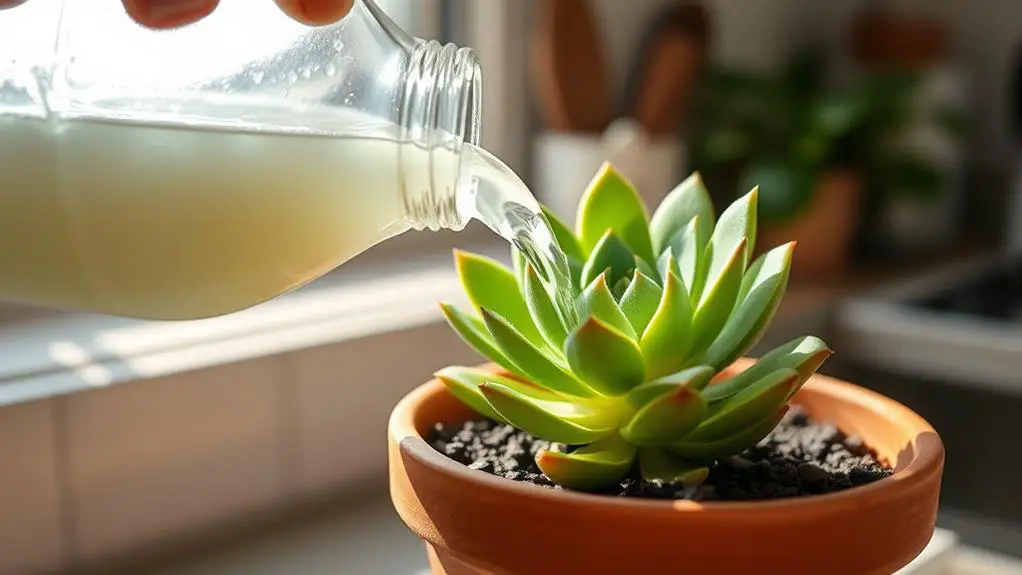
When using leftover pasta water to nourish your succulents, it's important to determine how often to apply it for ideal plant health. The right frequency of application guarantees your succulents get the nutrients they need without being overwhelmed.
It's best to apply pasta water every 2-4 weeks during the growing season. This schedule provides a steady supply of nutrients while giving the soil time to dry out, which prevents root rot. Succulents are sensitive to overwatering, so keeping an eye on moisture levels is vital.
Here's a helpful guide to keep your plants thriving:
- Monitor soil moisture: Check the soil regularly to avoid overwatering.
- Dilute pasta water: Mix it with regular distilled water in a 1:1 ratio to prevent starch buildup.
- Supplement, don't replace: Use pasta water as an addition to your regular fertilizing routine.
- Observe plant health: Look for signs of over-fertilization or stress and adjust as needed.
Following these tips guarantees your succulents receive just the right amount of nutrients from the pasta water without any negative effects. By paying attention to their needs, you'll help your succulents grow strong and healthy.
Common Mistakes to Avoid
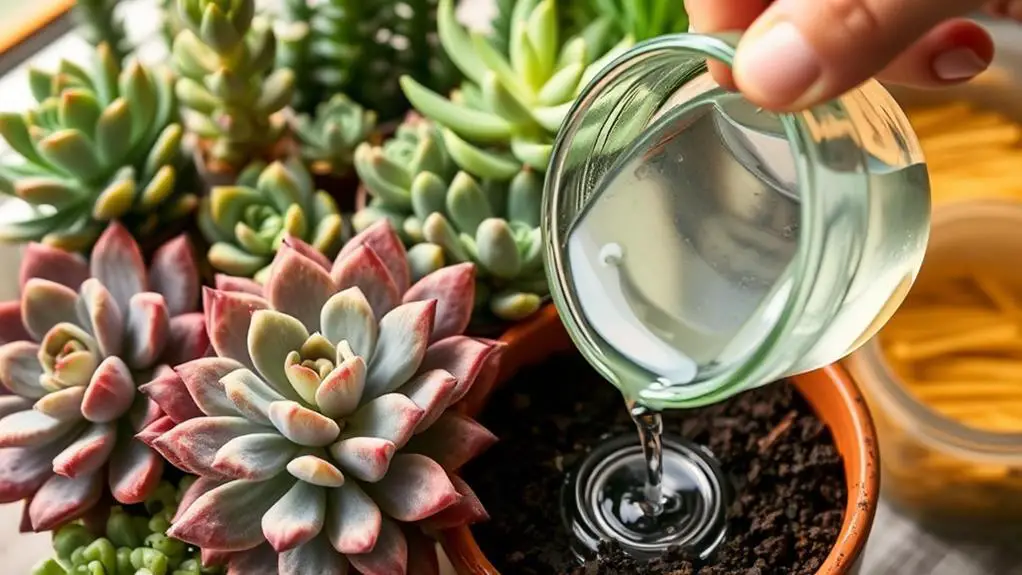
Applying leftover pasta water to your succulents can be beneficial, but it's crucial to avoid common mistakes that could harm your plants.
One key mistake is using pasta water that contains added salt or oil. Salt can dehydrate your succulents, while oil can clog the soil, preventing proper water absorption. Always use unsalted and oil-free pasta water for your plants.
Another common mistake is applying hot pasta water. Make sure the water is cooled to room temperature before using it on your succulents. Hot water can cause thermal shock, damaging the roots and potentially killing your plant.
Additionally, strain any solid remnants from the pasta water. Leftover bits of pasta can lead to mold growth, which is harmful to your succulents. A clean water application is a great way to conserve resources while keeping your plants healthy.
Monitoring Plant Health
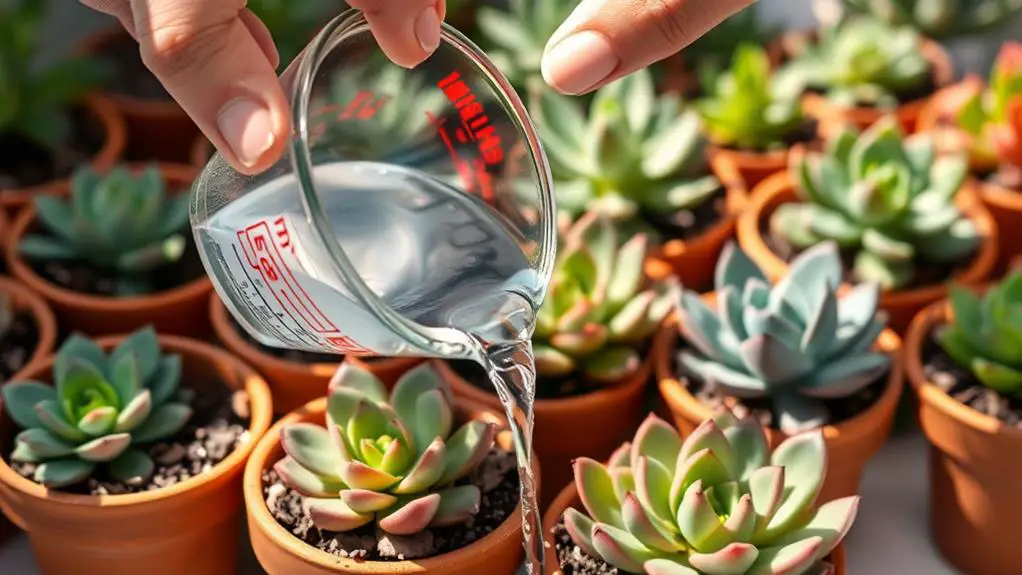
After taking care to avoid common mistakes, it's important to focus on monitoring your plants' health. Keeping an eye on your succulents guarantees they're benefiting from the pasta water you're using. Here's how you can do that effectively:
- Check soil moisture levels: Regularly check the soil after applying pasta water. Too much moisture can lead to root rot, which succulents are particularly prone to.
- Observe the growth patterns: Look for new leaf growth or discoloration. These changes can help you assess if the pasta water is helping or if adjustments are needed.
- Monitor for pests or fungal infections: The starch in pasta water can attract pests and fungi. Keep an eye out for any signs of these issues to catch them early.
- Adjust the frequency: Based on how your succulents respond, you might need to change how often you use pasta water. Typically, watering every 2-4 weeks during the growing season works well.
Keep a record of your observations. Noting changes in your succulents' health and growth will help you see any patterns and make better decisions.
This way, you'll give your succulents the best care possible while using leftover pasta water.
Additional Succulent Care Tips
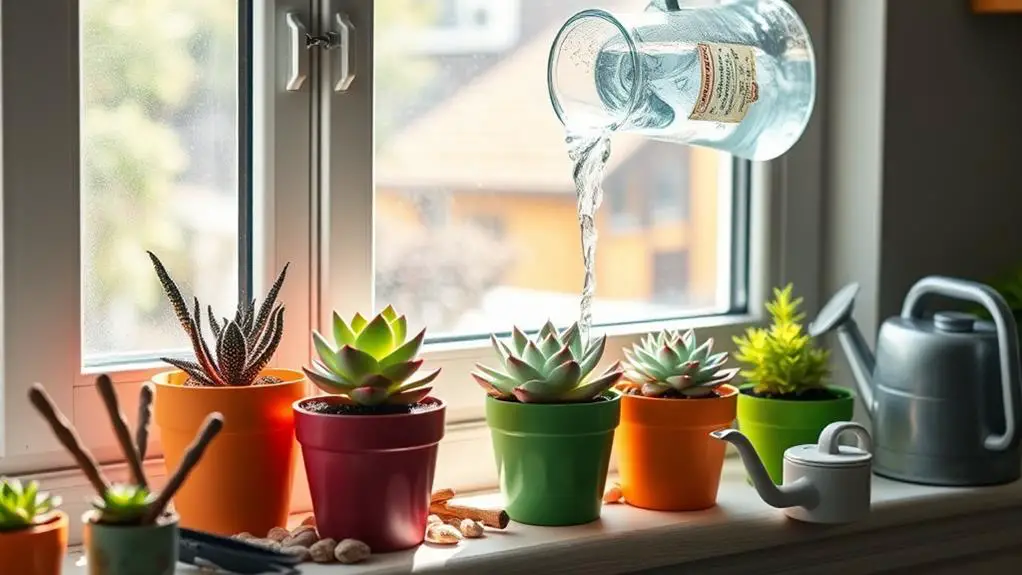
Caring for succulents goes beyond just watering them with leftover pasta water. To keep your succulents thriving, start by planting them in well-draining soil. This type of soil prevents water retention, which is essential because too much moisture can cause root rot.
Always use pots with drainage holes to allow excess water to escape, ensuring the soil stays at the right moisture level.
Adjust your watering schedule based on the seasons. Succulents typically need more water during their active growing season in spring and summer, and less in the winter. Using leftover water from cooking pasta can be a great supplement, but remember to let the soil dry out completely between waterings. You can check the soil's dryness with your finger or use a moisture meter for accuracy.
Regularly prune any dead or damaged leaves. This not only promotes healthier growth but also improves air circulation around the plant. Healthy leaves mean a healthier plant overall.
Frequently Asked Questions
Is Pasta Water Good for Succulents?
Yes, pasta water is good for succulents. It's rich in nutrients like calcium and potassium, supporting healthy growth. Make certain the water is unsalted and cooled before using it every 2-4 weeks during the growing season.
Is Leftover Pasta Water Good for Plants?
Yes, leftover pasta water is good for plants. It's rich in nutrients like potassium and calcium, which promote growth. Just make sure it's unsalted and cooled before use, and apply every few weeks for best results.
What Should I Do With Leftover Pasta Water?
You should save leftover pasta water to use as an organic fertilizer for your plants. Confirm it's cooled and unsalted, then mix it with distilled water. Apply it to your succulents every 2-4 weeks during the growing season.
How Long Can You Keep Pasta Water in Refrigerator for Plants?
You can keep pasta water in the refrigerator for up to three days. Make sure it's cooled to room temperature and strained before storing. Always check for off-smells or spoilage before using it on your plants.
Conclusion
You've got all the tips you need to use leftover pasta water to nourish your succulents! Remember to keep the water unsalted, strain it, and dilute it before use. Stick to the recommended watering schedule and watch your plants thrive. Don't forget to monitor their health and adjust as needed. With a bit of care and attention, your succulents will flourish. Happy gardening, and enjoy the process of helping your plants grow strong and healthy!

